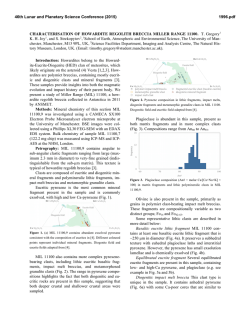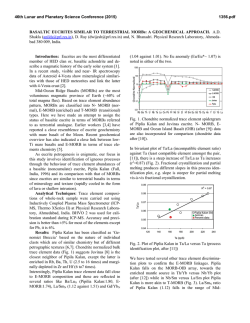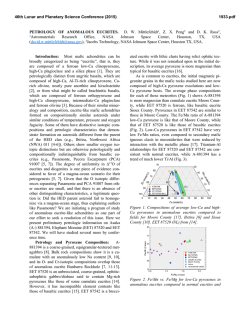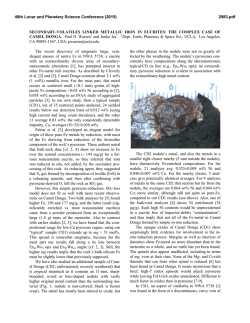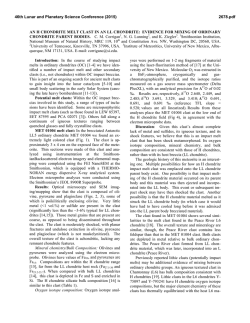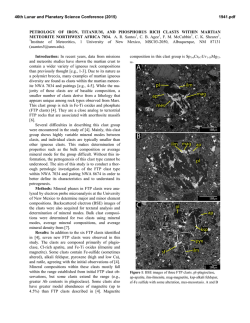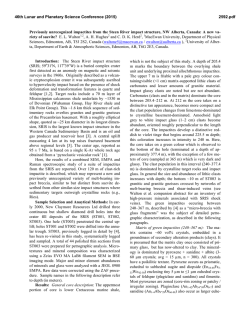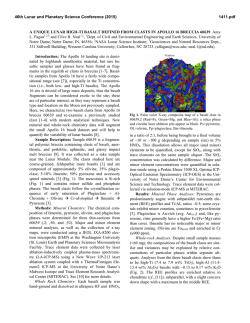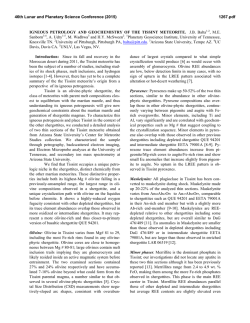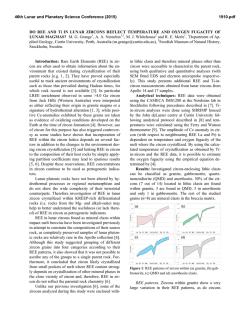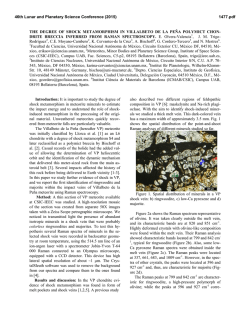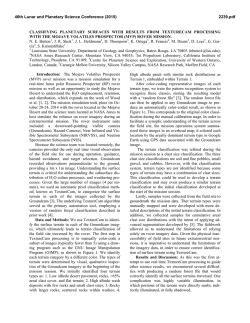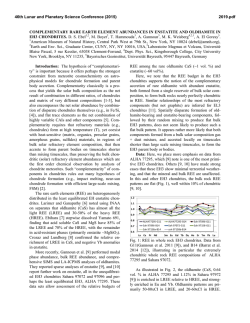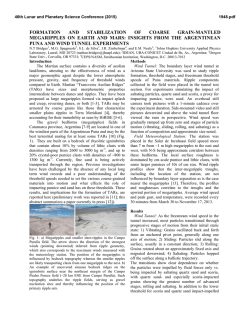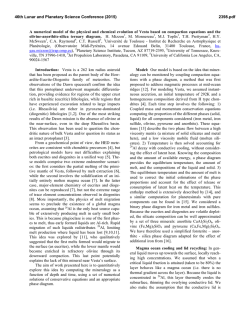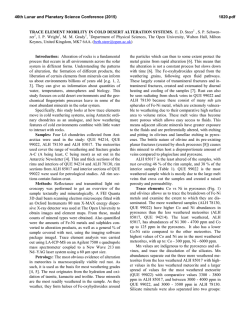
PIPLIA KALAN EUCRITE : IS IT A FRAGMENT OF DEEP SEATED
46th Lunar and Planetary Science Conference (2015) 1064.pdf PIPLIA KALAN EUCRITE : IS IT A FRAGMENT OF DEEP SEATED CRUST OF 4 VESTA ASTEROID? S. Ghosh and D. Ray. Physical Research Laboratory, Ahmedabad 380 009, India. E-mail: [email protected]. Introduction: Piplia Kalan meteorite (Fall of 1996, Western India) is a non-cumulate basaltic eucrite belonging to ‘Genomict Breccia’ based on petrography and chemistry [1, 2, 3]. Trace element abundances further classify it to Main Group (MG) Eucrite [2] as well as Neuvo Laredo (NL) trend eucrite [1]. We present here a new set of data on mineralogy, textures, metamorphism (thermal and shock) and whole- rock chemistry (major, trace including REE) to understand its petrogenesis and its relation to parent body, 4 Vesta asteroid . Analytical Techniques: Mineral composition of the clast lithologies was carried out using EPMA (Cameca SX 100) with wavelength dispersive spectromer. Mineral phases were analysed using 15 keV accelerating voltage, 20 nA sample current with a focused beam. Natural and synthetic mineral standards were used for calibration. Data were corrected for absorption, fluorescence and atomic number effects based on the correction method [4]. We considered only one bulk analysis of a 15g fragment comprising of matrix and clasts of different lithologies [5] instead of weighted average of seven analysis [3] of individual clasts and matrix and the analytical technique followed for major and minor element analysis is described [6]. Results: We report here a new opaque-rich (~ 60% troilite, 30% chrome- spinel and 10% ilmenite) pyroxene- hornfels clast (Fig. 1) besides three predominant common varietes viz. coarse grained gabbroid clast (Fig. 2), fine grained eucritic clast (Fig. 3) and very fine grained to cryptocrystalline granular clast of indistinct mineralogy. Troi Fig. 1 Opaque (troilite, chrome- spinel & ilmenite)rich pyroxene hornfels clast (PPL) Feld Fig. 2 Coarse grained gabbroid clast showing turbid appearance due to rod- shaped inclusions and incipient mosaicism (PPL). Piplia Kalan based on automode EPMA, comprises ~ 34% plagioclase, ~25% orthopyroxene, ~7% low-Ca pyroxene, ~18% high-Ca pyroxene, ~7% free SiO2polymorph, ~6% pulverised clastic matrix and ~3% opaques that include ilmenite, ulvospinel, troilite, chromite and Fe-Ni metal. Px Feld Fig. 3 Fine grained eucritic clast showing intense fracturing of feldspar and pyroxene laths (XPL). Piplia Kalan is a ferroan pyroxene dominated basalt with bytownitic feldspar (An86.5) as the other dominant mineral. Based on chemical zoning, exsolution and transformation of pigeonite to orthopyroxene as indicators of post-crystallization history [7] Piplia kalan pyroxenes belong to type 6 Eucrites where part of the host low-Ca pyroxene is inverted to orthopyroxene and both of these exhibit high-Ca pyroxene as exsolved lamellae. These three pyroxene phases constitute a linear trend from ferrohypersthene (mean Fs62.9) to ferroaugite (mean En28.4Fs27.5Wo44.1) through FePigeonite (mean En33.6Fs57.8Wo8.6). Turbid appearance of plagioclase and clouded pigeonites are ubiquitous and could be related to extensive secondary subsolidus reheating events [8]. Slowly cooled equilibrium texture of the coarse gabbroid clasts are part of the noncumulate eucrites originated from crystallization of basaltic lava just below the crust and this, in no way represents the cumulate eucrites because of two factors 46th Lunar and Planetary Science Conference (2015) 6 pyroxenes imply that this meteorite could be a fragment of deep seated crust of the 4 Vesta asteroid. 5. Piplia Kalan is a less fractionated main group basaltic eucrite with a REE pattern like Juvinas (MG Eucrite) and less evolved than Neuvo Laredo (NL trend Group). 6 La (ppm) Stannern trend 4 Main Group Eucrite MG-NL trend 2 1 2 FeOtotal/MgO 3 Nuevo Laredo Juvinas Piplia Kalan (lit) Piplia Kalan (Present data) Fig. 4 Plot of Piplia Kalan with respect to Juvinas and Neuvo Laredo in La versus (FeOtotal/MgO) diagram 100 Chondrite Normalised viz., complete absence of magnesian pigeonites and anorthitic plagioclase. Textural and optical evidences of severe shock effects in Piplia Kalan are many and some of these are loss of birefringence, anomalous extinction, bending and faulting of twin lamellae in both plagioclase and pigeonite grains, rounding of clasts due to attrition, pulverized bands within shockfractured pyroxenes, besides an ubiquitous signature of intense fracturing in both plagioclase and pyroxene grains. Our whole-rock major element composition data includes 0.33 wt% FeS and 0.04 wt% metal Fe [5] which is texturally and mineralogically supported from troilite-rich clast. Piplia Kalan is re- confirmed as ‘Basaltic Eucrite’ based on CaO versus MgO (10.14 wt% and 6.13 wt%) relationship [9] and belongs to Neuvo Laredo (NL) trend, fractionated member of the Main Group (MG) eucrite based on mg# versus TiO2 (37.05, 0.89 wt%) relationship [9,10]. Considering significant role of incompatible lithophile elements in the Magma Ocean model [11] our trace element data plot in La versus (FeOtotal / MgO) diagram (Fig. 4) and in La versus Sc diagram define MG- NL trend with a minor degree of melt fractionation whereas in the chondrite-normalized REE variation diagram (Fig. 5) similar petrogenesis is confirmed from unfractionated REE pattern of Piplia Kalan. The REE pattern is almost flat (La/YbN ~1.1) and resemble with Juvinas (classical MG member) but depleted as compared to Neuvo Laredo eucrite (classical NL member). Discussion: In a review on petrogenesis of basaltic eucrites, Barrat et al [11] have pointed out for two distinct processes of which the most dominant is the partial melting followed by fractional crystallization for the origin of MG- NL group of eucrites and a minor process of assimilation fractional crystallization (AFC) of the MG magma by the impact- triggered crustal melt for the Stannern group of eucrites. Petrogenesis of Piplia Kalan has been examined with reference to this unique model because it has taken care of all the constraints of earlier models. 1. Texture and mineralogy of Piplia Kalan clasts suggest their derivation from a basaltic lava which had formed the asteroid crust under equilibrium crystallisation with variable cooling rates. 2. Subsequent cataclasis by the impact during growth of the young crust formed the ‘Genomict Breccia’ through the mixing of crust and subcrustal ejecta. 3. Thermal metamorphism of the genomict clasts caused by reheating at buried depth accounts for hornfels texture, compositional homogeneity, matrix- clast welding, feldspar turbidity and clouding of pyroxene. 4. Presence of rare troilite- rich clast and highest degree of thermal metamorphism, as inferred from Type 1064.pdf 10 Juvinas Nuevo Laredo Piplia 1 La Ce Pr Nd Sm Eu Gd Tb Dy Ho Er Yb Lu Fig.5 Chondrite normalized REE pattern of Piplia Kalan with respect to Juvinas and Neuvo Laredo eucrites. Acknowledgements: Director General, GSI is gratefully acknowledged for approving Project Meteorite. References: [1] Vaya V.K. et al (1996) Curr. Sci. 71, 253-257. [2] Shukla A.D. et al (1997) Met. Planet. Sci. 32, 611-615. [3] Buchanan P.C. et al (2000) Met. Planet Sci. 35, 609-615. [4] Pouchon J. L. and Pichoir F. (1991) New York: Plenum Press. pp. 31–75. [5] Ghosh S. and Bhattacharya A.K. (1997) Unpub. GSI Report F.S. 1996-97. [6] Dasgupta S.P. et al (1978) Min. Mag. 42, 493-497. [7] Takeda H. and Graham A.L. (1991) Meteoritics 26, 129-134. [8] Harlow G.E. and Klimentidis R. (1980) 11th Proc LPSC 1131-1148. [9] Mittlefehldt D.W. et al. (1998) Rev. Mineral. 36, 4.1-4.195. [10] Warren P.H. and Jerde E. (1987) Geochim. Cosmochim. Acta 51, 713-725. [11] Barrat J.A. et al (2007) Geochim. Cosmochim. Acta 71, 4108-4124.
© Copyright 2026
